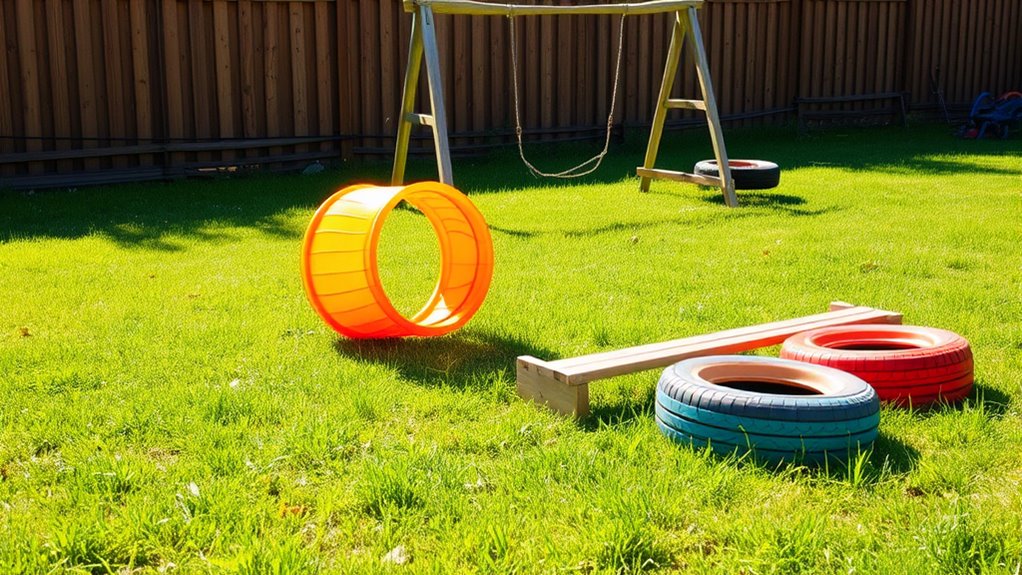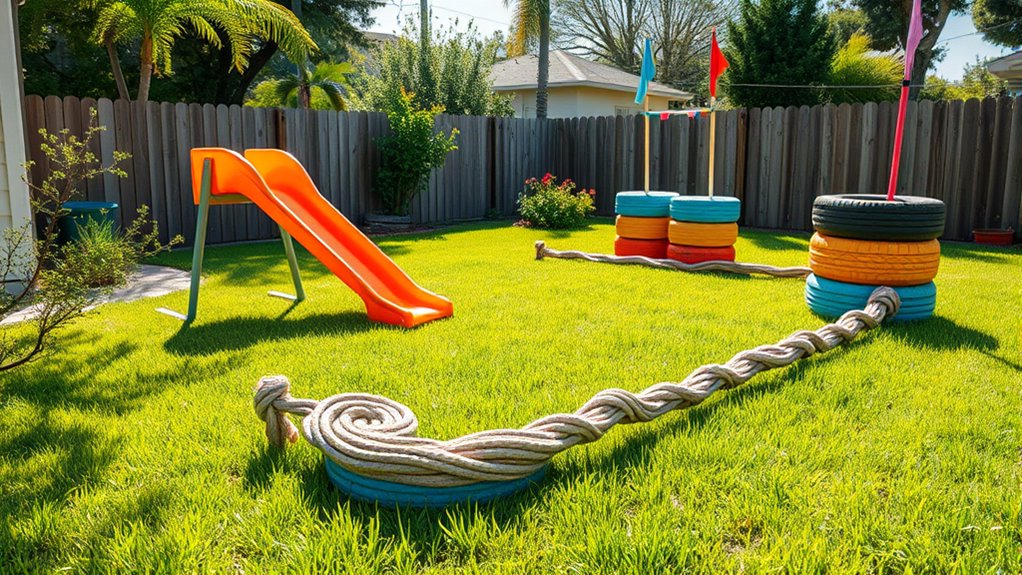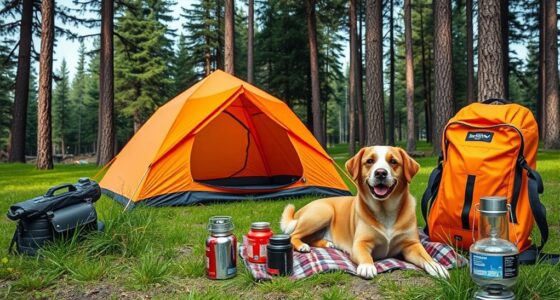To create a DIY backyard obstacle course on a budget, start by using items you already have, like laundry baskets, cones, or cardboard boxes, to design fun challenges. Secure all obstacles firmly and add soft landing zones such as grass or mats for safety. Incorporate simple materials like ropes, pool noodles, or old tires for added fun. Focus on safety and creativity, and you’ll be surprised at how much you can do. Keep going to discover more tips to make it even better.
Key Takeaways
- Use household items and repurposed materials like cardboard, laundry baskets, and wooden pallets to create affordable obstacles.
- Prioritize safety by securing obstacles, adding soft landing zones, and inspecting structures regularly.
- Plan a simple, scalable design and add obstacles gradually to stay within your budget.
- Incorporate inexpensive supplies like cones, ropes, and old tires to diversify obstacles.
- Enhance visibility and safety with outdoor lighting and clear safety rules for fun, injury-free play.

Creating a DIY backyard obstacle course is a fun and rewarding way to keep your family active and entertained. As you start planning, it’s essential to prioritize safety precautions to prevent injuries and ensure everyone has a good time. Before you gather supplies, take a walk through your yard and identify potential hazards—sharp edges, uneven surfaces, or fragile objects—that could pose risks. Make sure to clear the area of debris and sharp objects, and consider adding soft landing zones like grass or mats under climbing or jumping sections. It’s also a good idea to set rules for safe play, like no pushing or roughhousing, especially if kids are involved. Being proactive about safety helps you avoid accidents and gives everyone confidence to enjoy the course. Additionally, incorporating wicks or candles into your backyard setup can add a cozy ambiance and increase visibility during evening play. Budget planning plays a key role in creating your obstacle course without breaking the bank. You don’t need expensive equipment to build something fun and functional. Start by brainstorming what obstacles you’d like to include—think simple items like cones, ropes, or old tires. Use items you already have around the house, such as laundry baskets, pool noodles, or cardboard boxes, which can be transformed into challenging obstacles. If you need to purchase supplies, set a clear budget beforehand. Look for deals at dollar stores or thrift shops, and consider repurposing materials to save money. For example, a sturdy wooden pallet can become a climbing wall or a balance beam. Keep the design simple and scalable; you can always add more obstacles later as funds allow. Remember, creativity and resourcefulness are your best friends here. As you build your course, always keep safety at the forefront. Secure all obstacles firmly to prevent shifting or collapsing during play. Use non-slip tape or mats on surfaces where kids will be running or jumping. If you’re constructing structures, check for stability and sharp edges. Regularly inspect the obstacles for signs of wear and tear, replacing or repairing parts as needed. Encourage kids to wear appropriate footwear and to follow safety rules to avoid injuries. By combining thoughtful safety precautions with smart budget planning, you’ll create an engaging obstacle course that’s both affordable and safe. It’s a fantastic way to promote active play and family bonding without overspending, turning your backyard into an exciting adventure zone for everyone.
Frequently Asked Questions
What Safety Precautions Should I Take During Construction?
When building your obstacle course, you should prioritize safety precautions. Always wear safety gear like gloves, goggles, and sturdy shoes to protect yourself during construction. Follow a supervision protocol, ensuring someone oversees the process to prevent accidents. Keep the work area clear of hazards, and double-check all structures for stability before use. Taking these steps helps minimize risks and keeps you safe while creating your backyard adventure.
How Can I Make the Course More Challenging?
Ever wondered how to push your limits with an advanced obstacle? To make your course more challenging, incorporate obstacle scaling and varied difficulty levels. Add taller walls, tighter tunnels, or swinging elements to test agility and strength. You could also introduce timed challenges or multi-stage obstacles. These tweaks keep the course engaging, demanding more skill and stamina, and guarantee you’re constantly advancing your obstacle course skills.
What Budget-Friendly Materials Work Best?
You can make your obstacle course more challenging by using budget-friendly materials like recycled items and paint alternatives. Think about old tires, wooden pallets, or plastic barrels for obstacles, which are inexpensive and eco-friendly. Instead of costly paint, use natural or homemade alternatives like vinegar and food coloring for markings. These materials are durable, affordable, and easy to find, helping you create a fun, challenging course without breaking the bank.
How Do I Maintain the Obstacle Course?
To maintain your obstacle course, regularly inspect for wear and tear, ensuring obstacle durability stays high. Clean surfaces often to prevent dirt buildup and check for loose or damaged parts. To enhance weather resistance, seal wooden elements and move or cover materials during storms or heavy rain. By maintaining your course this way, you’ll keep it safe, functional, and enjoyable for everyone, no matter the weather or how often you use it.
Are There Age-Appropriate Obstacle Ideas?
Ever wondered how to keep your kids safe while challenging their abilities? You should focus on age-appropriate challenges that match their skills, ensuring they’re fun and safe. For younger children, use soft materials and simple tasks, while older kids can handle more complex obstacles. Always consider safety considerations, like sturdy structures and proper supervision, to prevent accidents. Wouldn’t you love to create a course that everyone can enjoy safely?
Conclusion
Building your own backyard obstacle course on a budget isn’t just fun—it can boost your confidence and fitness too. While some believe that DIY projects always lack durability, recent studies show that with proper materials and planning, they can be surprisingly resilient. So, don’t dismiss the idea just yet. With creativity and effort, you’ll create a challenging, affordable course that encourages healthy activity and brings family and friends together, proving that great things don’t have to cost a lot.










